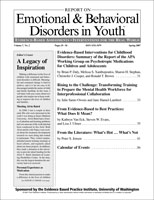Expanding Interdisciplinary Collaboration in School Mental Health: The Role of Graduate Programs
Author: Cindy L. Buchanan.; Brian P. Daly.; Leslie K. Taylor.; Mark D. Weist.; Abraham Wandersman.
Source: Volume 11, Number 03, Summer 2011 , pp.67-72(6)

< previous article |next article > |return to table of contents
Abstract:
Over the past two decades, school mental health programs have garnered increasing attention from researchers, policymakers, mental health professionals, and school staff. This is not surprising given the identified gap between youth mental health needs and service availability. For example, approximately 20% of youth present with emotional and behavioral problems severe enough to warrant intervention (Costello et al., 1996; Grunbaum et al., 2004; Roberts et al., 1998), yet fewer than one-fifth of these youth receive specialized mental health services (Burns, 2010; Burns et al., 1995; Leaf et al., 1996; U.S. Department of Health and Human Services, 2004). To better meet student needs and provide mental health services to all students, many [of these] programs are now reflecting an expanded school mental health (ESMH) approach that involves collaboration among school staff, community system staff and families, and other stakeholders to move toward a full continuum of mental health promotion that includes environmental enhancement, prevention, early intervention, and treatment for youth and their families in both general and special education (Weist, 1997; Weist & Evans, 2005).Keywords: improved mental health outcomes, theoretical models, graduate training programs, professional role confusion, interconnected training
Affiliations:
1: University of Colorado Anschutz; 2: Drexel University; 3: University of South Carolina; 4: University of South Carolina; 5: University of South Carolina.